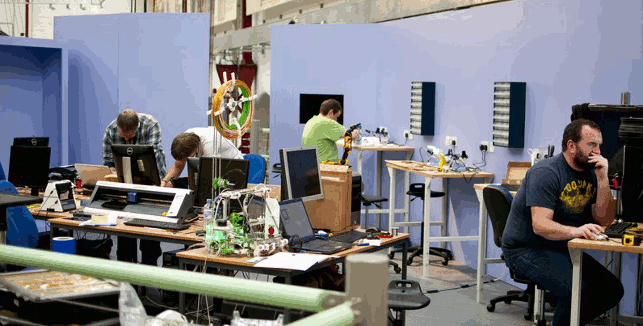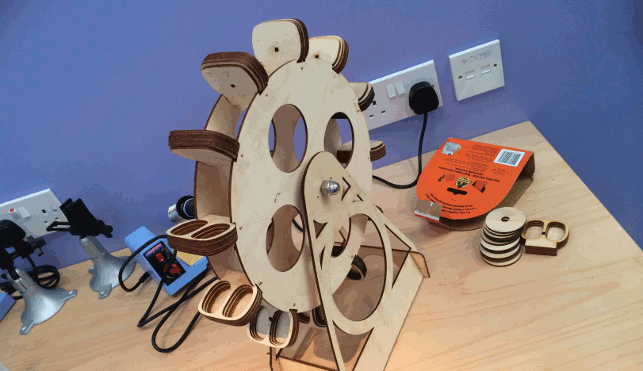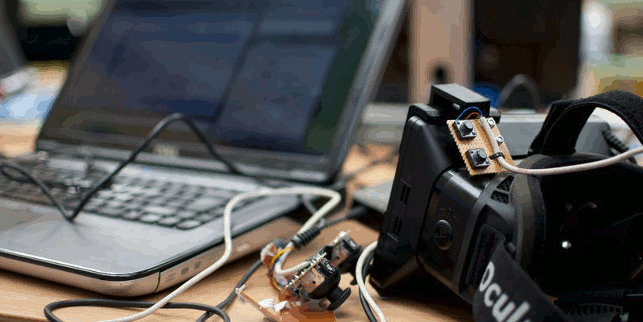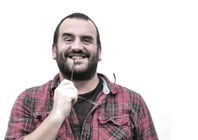Maker — an old term that has become a new thing. Al Dean develops a new love for the smell of burning plywood in the morning as he takes part in a weekend of making at the birthplace of the first industrial revolution
It’s cold in these here hills. It’s 7am on a November morning and I’m in Ironbridge, Shropshire. I’m stood, leant against my clapped out yet inexplicably road worthy Hyundai and my view is the very furnace where Abraham Darby first coke smelted iron ore in 1704.

The FabLab team — hacking, making, giggling a lot and struggling to recall how to convert from inch to mm at 11pm
Just down the road is the world famous Ironbridge, which was built by ol’ Abe’s great grandson, also an Abraham. It was the first cast iron bridge constructed using this revolutionary coke smelting process. Woodworking joints were used and according to the history books, this simply hadn’t been done before.
So why have I forsaken a warm bed on a chilly Friday morning? The answer is I’m on my way to Museomix.
Billed as part hackathon, part reimagining of museums, part community led effort, Museomix aims to inject some new thinking into the world of museums, which, as with many things these days, needs a bit of a spruce up.
In three days participants form teams, think up ideas, refine and work on one idea and then deliver a prototype on the Sunday evening.
To be honest, I’m not entirely clear how I ended up filling the boot of my car with a workstation, a bright red toolbox and a 3D printer, but here I am.
Small teams, big ideas
Museomix was started in France as a way of pulling together a disparate set of people to reinvent and remix museum exhibits.
It’s been run in France over the last couple of years, but this year saw it move into both Canada and the UK. As a location for this type of thing, the Ironbridge museums are a perfect choice.
While the history is rich and important to the world at large (the area is a world heritage site), its museums are a little tired.

Laser cut Pelton Turbine wheel — built for a prototype water-based exhibit
Perhaps the brightest star (apart from the Victorian quaintness of Blists Hill) is Enginuity. It’s a science museum chock full of exhibits that are intended to turn kids on to science and engineering.
The reality is that it’s ten years old and, while ground breaking when it launched, today it’s a little tired and needs a rethink for today’s youngsters.
Another reason for Enginuity playing host is that the museum has just installed a FabLab. Part of the global network of similar facilities, this brings together, in principle, state of the art technology (3D printers, laser cutters, CNC routers, etc.) with more traditional crafts (screen printing) and opens them up to the public.
What happened?
Bring together a bunch of smart people, each with their own passions, ideas and skill sets, and you get an interesting mix.
The event runs along the format that ideas are pitched, teams formed, ideas are fleshed out and updates delivered at the end of each day.
The reality is that there’s a lot of discussions (read: arguments and toys being thrown out of the pram) on the first day, but then teams settle into work and start to come up with the prototypes.
My role along with the others in the FabLab was to support and help build things out.

Hacked controls for an Occulus Rift VR headset on a 3D printed attachment
Chris from the local college brought his mastery of 3D printers, David and Simon from the Manchester FabLab brought their experience with a set of machinery and I helped out with design and fabrication.
Then the tech team from MixedReality brought their knowledge of VR, augmented reality and how to make things work together to add interactivity.
Over the course of two days we got involved in all manner of stuff from remodelling and 3D printing replicas of Darby cookware to building a Pelton Water Turbine with laser cut ply. We even adapted an attachment from an Occulus Rift VR headset from Thingiverse to add movement controls directly to the headset.
We learned what made the machines work, how to optimise the process, under pretty tight deadlines, answered questions about 3D scanning with a Kinect (answer: it’s quicker with a tape measure and eyeballing it), and generally had a bit of a giggle.
I also learned that it’s surprisingly easy to set fire to a laser cutter and that you shouldn’t trust the Chinese/English manual when it comes to default settings.
The end result
On Sunday, as the sun set over the birth place of the industrial revolution, seven prototypes where unveiled.
There were those that celebrated the power of water and energy generation. One interactive exhibit showed how you can connect your phone to your location. There was even one that told the story of a cast iron pot used to render whale fat. Everything was delivered on time and worked, as best it could.
Everyone involved worked their arses off for three days, learned a great deal and made some friends along the way. We all went home pretty tired, but happy. Would I do it again next year? I’m already booked in.
Al Dean participates in a weekend of making with technology old and new
Default






